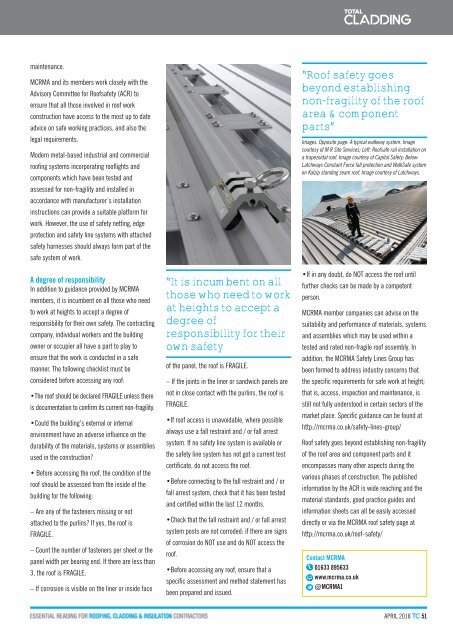April 2018
Create successful ePaper yourself
Turn your PDF publications into a flip-book with our unique Google optimized e-Paper software.
maintenance.<br />
MCRMA and its members work closely with the<br />
Advisory Committee for Roofsafety (ACR) to<br />
ensure that all those involved in roof work<br />
construction have access to the most up to date<br />
advice on safe working practices, and also the<br />
legal requirements.<br />
Modern metal-based industrial and commercial<br />
roofing systems incorporating rooflights and<br />
components which have been tested and<br />
assessed for non-fragility and installed in<br />
accordance with manufacturer’s installation<br />
instructions can provide a suitable platform for<br />
work. However, the use of safety netting, edge<br />
protection and safety line systems with attached<br />
safety harnesses should always form part of the<br />
safe system of work.<br />
A degree of responsibility<br />
In addition to guidance provided by MCRMA<br />
members, it is incumbent on all those who need<br />
to work at heights to accept a degree of<br />
responsibility for their own safety. The contracting<br />
company, individual workers and the building<br />
owner or occupier all have a part to play to<br />
ensure that the work is conducted in a safe<br />
manner. The following checklist must be<br />
considered before accessing any roof:<br />
•The roof should be declared FRAGILE unless there<br />
is documentation to confirm its current non-fragility.<br />
•Could the building’s external or internal<br />
environment have an adverse influence on the<br />
durability of the materials, systems or assemblies<br />
used in the construction?<br />
• Before accessing the roof, the condition of the<br />
roof should be assessed from the inside of the<br />
building for the following:<br />
– Are any of the fasteners missing or not<br />
attached to the purlins? If yes, the roof is<br />
FRAGILE.<br />
– Count the number of fasteners per sheet or the<br />
panel width per bearing end. If there are less than<br />
3, the roof is FRAGILE.<br />
– If corrosion is visible on the liner or inside face<br />
“It is incumbent on all<br />
those who need to work<br />
at heights to accept a<br />
degree of<br />
responsibility for their<br />
own safety<br />
of the panel, the roof is FRAGILE.<br />
– If the joints in the liner or sandwich panels are<br />
not in close contact with the purlins, the roof is<br />
FRAGILE.<br />
•If roof access is unavoidable, where possible<br />
always use a fall restraint and / or fall arrest<br />
system. If no safety line system is available or<br />
the safety line system has not got a current test<br />
certificate, do not access the roof.<br />
•Before connecting to the fall restraint and / or<br />
fall arrest system, check that it has been tested<br />
and certified within the last 12 months.<br />
•Check that the fall restraint and / or fall arrest<br />
system posts are not corroded: if there are signs<br />
of corrosion do NOT use and do NOT access the<br />
roof.<br />
•Before accessing any roof, ensure that a<br />
specific assessment and method statement has<br />
been prepared and issued.<br />
“Roof safety goes<br />
beyond establishing<br />
non-fragility of the roof<br />
area & component<br />
parts”<br />
Images. Opposite page: A typical walkway system. Image<br />
courtesy of M R Site Services; Left: Roofsafe rail installation on<br />
a trapezoidal roof. Image courtesy of Capital Safety; Below:<br />
Latchways Constant Force fall protection and WalkSafe system<br />
on Kalzip standing seam roof. Image courtesy of Latchways.<br />
•If in any doubt, do NOT access the roof until<br />
further checks can be made by a competent<br />
person.<br />
MCRMA member companies can advise on the<br />
suitability and performance of materials, systems<br />
and assemblies which may be used within a<br />
tested and rated non-fragile roof assembly. In<br />
addition, the MCRMA Safety Lines Group has<br />
been formed to address industry concerns that<br />
the specific requirements for safe work at height;<br />
that is, access, inspection and maintenance, is<br />
still not fully understood in certain sectors of the<br />
market place. Specific guidance can be found at<br />
http://mcrma.co.uk/safety-lines-group/<br />
Roof safety goes beyond establishing non-fragility<br />
of the roof area and component parts and it<br />
encompasses many other aspects during the<br />
various phases of construction. The published<br />
information by the ACR is wide reaching and the<br />
material standards, good practice guides and<br />
information sheets can all be easily accessed<br />
directly or via the MCRMA roof safety page at<br />
http://mcrma.co.uk/roof-safety/<br />
Contact MCRMA<br />
01633 895633<br />
www.mcrma.co.uk<br />
@MCRMA1<br />
APRIL <strong>2018</strong> TC 51

















